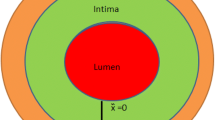Abstract
Atherosclerosis begins as an inflammation in blood vessel walls (intima). The inflammatory response of the organism leads to the recruitment of monocytes. Trapped in the intima, they differentiate into macrophages and foam cells leading to the production of inflammatory cytokines and further recruitment of white blood cells. This self-accelerating process, strongly influenced by low-density lipoproteins (cholesterol), results in a dramatic increase of the width of blood vessel walls, formation of an atherosclerotic plaque and, possibly, of its rupture. We suggest a 2D mathematical model of the initiation and development of atherosclerosis which takes into account the concentration of blood cells inside the intima and of pro- and anti-inflammatory cytokines. The model represents a reaction–diffusion system in a strip with nonlinear boundary conditions which describe the recruitment of monocytes as a function of the concentration of inflammatory cytokines. We prove the existence of travelling waves described by this system and confirm our previous results which suggest that atherosclerosis develops as a reaction–diffusion wave. The theoretical results are confirmed by the results of numerical simulations.
Article PDF
Similar content being viewed by others
Avoid common mistakes on your manuscript.
References
Chow CC, Clermont G, Kumar R, Lagoa C, Tawadrous Z, Gallo D, Betten B, Bartels J, Constantine G, Fink MP, Billiar TR, Vodovotz Y (2005) The acute inflammatory response in diverse shock states. Shock 24(1): 74–84
Edelstein-Keshet L, Spiros A (2002) Exploring the formation of Alzheimer’s disease senile plaques in silico. J Theor Biol 216(3): 301–326
El Khatib N, Genieys S, Volpert V (2007) Atherosclerosis initiation modeled as an inflammatory process. Math Model Nat Phenom 2(2): 126–141
Fan J, Watanabe T (2003) Inflammatory reactions in the pathogenesis of atherosclerosis. J Atheroscler Thromb 10: 63–71
Kazmierczak B (2009) Existence of global solutions to a model of chondrogenesis. Math Meth Appl Sci 32(3): 264–283
Krasnoselskii MA, Zabreiko PP (1984) Geometrical methods of nonlinear analysis. Springer, New York
Ladyzhenskaya OA, Solonnikov VA, Uraltseva NN (1967) Linear and quasi-linear equations of parabolic type. Moskva, Nauka
LaRosa JC, He J, Vupputuri S (1999) Effect of statins on risk of coronary disease: a meta-analysis of randomized controlled trials. J Am Med Assoc 282: 2340–2346
Leiderman KM, Miller LA, Fogelson AL (2008) The effects of spatial inhomogeneities on flow through the endothelial surface layer. J Theor Biol 252: 313–325
Li Z-Y, Howarth SP, Tang T, Gillard JH (2006a) How critical is fibrous cap thickness to carotid plaque stability? A flow plaque interaction model. Stroke 37: 1195–1196
Li Z-Y, Howarth SP, Trivedi RA, U-King-Im JM, Graves MJ, Brown A, Wang L, Gillard JH (2006b) Stress analysis of carotid plaque rupture based on in vivo high resolution MRI. J Biomech 39(14): 2611–2612
Lieberman GM (1996) Second order parabolic differential equations. World Scientific, Singapore
Østerud B, Bjørklid E (2003) Role of monocytes in atherogenesis. Physiol Rev 83: 1070–1086
Poston RN, Poston DRM (2007) A typical atherosclerotic plaque morphology produced in silico by an atherogenesis model based on self-perpetuating propagating macrophage recruitment. Math Model Nat Phenom 2(2): 142–149
Protter MH, Weinberger HF (1967) Maximum principles in differential equations. Springer, Berlin
Ross R (1999) Atherosclerosis: an inflammatory disease. Mass Med Soc 340: 115–120
Vincent PE, Sherwin SJ, Weinberg PD (2009) The effect of a spatially heterogeneous transmural water flux on concentration polarization of low density lipoprotein in arteries. Biophys J 96(8): 3102–3115
Volpert AI, Volpert VA, Volpert VA (2000) Traveling wave solutions of parabolic systems. American Mathematical Society, Providence
Acknowledgments
The authors are grateful to John McGregor for discussions about the inflammatory aspect of atherosclerosis and clarifying some important details about the risk factors. B. Kazmierczak has been supported by the MNiSW grant N N201548738 and by the FNP project TEAM/2009-3/6.
Open Access
This article is distributed under the terms of the Creative Commons Attribution Noncommercial License which permits any noncommercial use, distribution, and reproduction in any medium, provided the original author(s) and source are credited.
Author information
Authors and Affiliations
Corresponding author
Rights and permissions
Open Access This is an open access article distributed under the terms of the Creative Commons Attribution Noncommercial License (https://creativecommons.org/licenses/by-nc/2.0), which permits any noncommercial use, distribution, and reproduction in any medium, provided the original author(s) and source are credited.
About this article
Cite this article
El Khatib, N., Genieys, S., Kazmierczak, B. et al. Reaction–diffusion model of atherosclerosis development. J. Math. Biol. 65, 349–374 (2012). https://doi.org/10.1007/s00285-011-0461-1
Received:
Revised:
Published:
Issue Date:
DOI: https://doi.org/10.1007/s00285-011-0461-1
Keywords
- Atherosclerosis
- Reaction–diffusion equations
- Nonlinear boundary conditions
- Existence of travelling waves
- Numerical simulations




